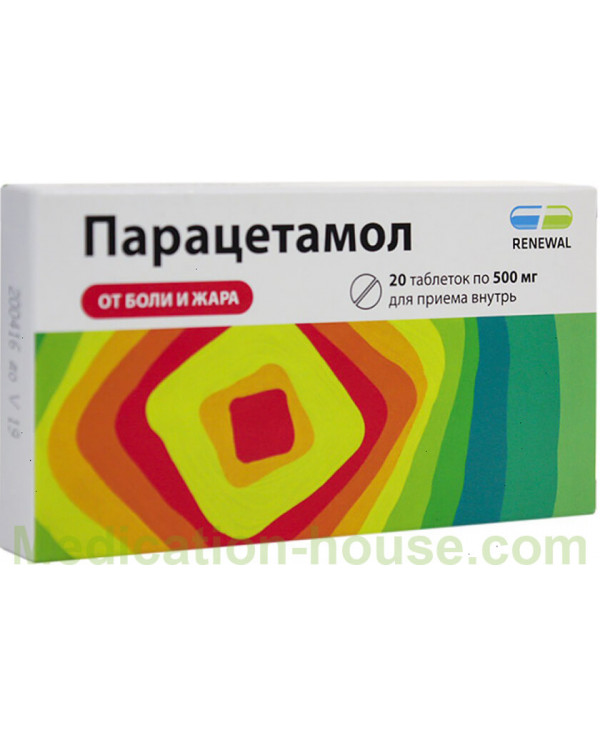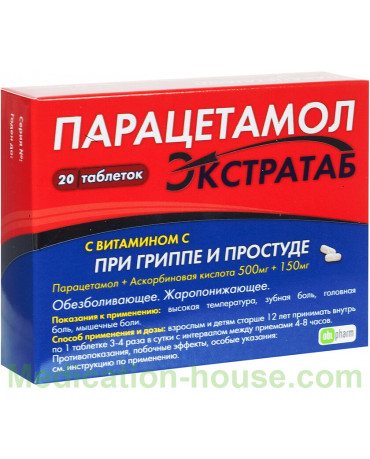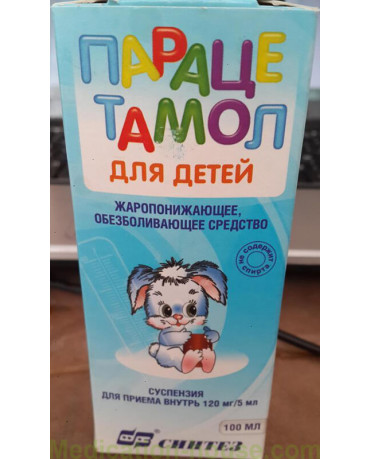Instruction for Paracetamol
You can buy Paracetamol on this page
Paracetamol is an analgesic and antipyretic from the group of NSAIDs (non-steroidal anti-inflammatory drugs), non-narcotic analgesic. The World Health Organization is included in the list of the most important medicines.
pharmachologic effect
The active substance of the drug is paracetamol, a phenacetin derivative. The mechanism of action of Paracetamol is based on the inhibition of the synthesis of prostaglandins - chemical compounds formed during inflammation, and responsible for its signs in the form of a rise in temperature and the appearance of pain. Paracetamol has an analgesic effect by acting on neurons of the central nervous system. It has a weak anti-inflammatory effect, does not irritate the mucous membrane of the gastrointestinal tract.
When it enters the body, the drug is absorbed into the blood, and from there it spreads throughout all body tissues. The destruction occurs in the liver, with the formation of intermediate metabolic products - metabolites, some of which (paraaminophenol) are toxic. This fact limits the use of Paracetamol in diseases of the liver and blood. Subsequently, the metabolites pass through the renal filters and are excreted in the urine, and therefore, with impaired renal function, the use of Paracetamol is also undesirable.
With oral administration, paracetamol reaches a maximum concentration in the blood 20-30 minutes after administration, after an hour and a half, the peak of the drug's action.
Release Forms
Paracetamol is available in the following forms:
Tablets for oral administration, with an active substance content of 200 and 500 mg;
Coated tablets for oral use (capsules), 500 mg paracetamol each;
Effervescent tablets for the preparation of a solution, 500 mg of active substance in one tablet;
Solution for infusion, 15 mg in 1 ml of solution, ampoules of 5 ml;
Syrup for children, 200 mg paracetamol in 5 ml of solution;
Suspension for children, 120 mg in 5 ml of solution;
Rectal suppositories with a dosage of the active substance from 50 mg (for children) to 1000 mg.
Paracetamol is one of the most famous and widely used drugs in the world, the same active substance is produced by different pharmaceutical companies.
Indications
Indication for Paracetamol is body temperature, elevated to subfebrile and febrile values (37 - 39 ° C) for various diseases of infectious and inflammatory origin. In pediatric practice, indications for Paracetamol are gum pain and fever caused by teething.
According to the instructions, Paracetamol is effective as a pain reliever for various origins: headache, myalgia, arthralgia, algodismenorrhea, radiculitis, sciatica, neuralgia, toothache and wandering pains of unknown etiology.
Attention! When using this drug to relieve acute pain, it can significantly reduce symptoms, and therefore the clinical picture of the disease will change and diagnosis may be difficult.
Instructions for use
A single dosage of Paracetamol according to the instructions is from 500 to 1000 mg for adults and children over 12 years old, the daily dosage for this group should not exceed 4 g (4000 mg) of the drug.
The dose of the drug for children is calculated individually, depending on the weight of the child, based on an average of 125-250 mg of active substance at a time, regardless of the dosage form. Regardless of the form of the drug, the daily dose must be divided into 3-4 doses, with a time interval between them of at least 4 hours.
In accordance with the instructions, Paracetamol should not be used for more than 3 days without medical supervision. If during this time the symptoms of the disease have not been reversed, it is necessary to consult a doctor about the possibility of further use of the drug and its dosage.
Side effects
Following the instructions, Paracetamol is one of the safest drugs, side effects of which are extremely rare. However, they are described in the medical literature, and are usually associated with increased individual sensitivity or with the presence of latent concomitant pathology.
Side effects associated with taking Paracetamol include:
From the digestive system - the development of liver dysfunctions, the appearance of signs of dyspepsia;
On the part of the blood - anemia, methemoglobinemia, deterioration of the blood picture (thrombocytopenia, agranulocytosis, leukopenia, etc.);
From the cardiovascular system - changes in cardiac conduction (intracardiac blockade);
On the part of the immune system - allergic reactions of varying intensity, often of a delayed type, less often immediate (anaphylactic shock);
On the part of the urinary organs - the development of interstitial nephritis, polyuria and other disorders of renal function.
A number of experts claim that there is evidence of the development of bronchial asthma in a significant number of children taking Paracetamol (41%). Despite the fact that this point of view is controversial in the scientific community, without serious evidence, Paracetamol should not be used in pediatric practice, especially if it should not be abused.
This drug is prescribed with caution in combination with other drugs, and only under the supervision of a doctor, since toxic effects from their interaction may be observed. The combined use of Paracetamol and alcohol is prohibited.
During pregnancy
It is believed that Paracetamol during pregnancy can be prescribed when the risk associated with its use is justified by its high effectiveness and extreme need. It should be borne in mind that a number of studies confirm the toxic effect on the fetus when using Paracetamol during pregnancy. Thus, cases of the development of cryptorchidism in boys whose mothers used it when they were pregnant are associated with this drug.
Thus, the appointment according to the indications of Paracetamol during pregnancy should occur exclusively with the participation of a doctor.
Contraindications
Paracetamol is contraindicated in the following situations:
The history of individual sensitivity to him or other NSAIDs;
Impaired liver function;
Pathology of the kidneys;
Diseases associated with a deterioration in the blood picture;
Pregnancy;
Breast-feeding.
Storage conditions
Store in a dark, dry place at a temperature not exceeding 25 ° C for 2 years. Keep out of reach of children!
Terms of sell
You can buy Paracetamol without a prescription.



